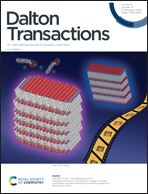How solvents affect the stability of cationic Rh(i) diphosphine complexes: a case study of MeCN coordination†
Abstract
Cationic rhodium(I) diphosphine complexes, referred to as Schrock–Osborn catalysts, are privileged homogeneous catalysts with a wide range of catalytic applications. The coordination of solvent molecules can have a significant influence on reaction mechanisms and kinetic scenarios. Although solvent binding is well documented for these rhodium species, comparative quantifications for structurally related systems are not available to date. We present a method for systematic investigation and quantification of this important parameter, using MeCN which replaces diolefins and forms stable Rh(I) MeCN complexes. Using UV-vis and 31P{1H} NMR spectroscopy we determine and compare stability constants of different [Rh(PP)(NBD)]BF4 and [Rh(PP)(COD)]BF4 complexes (PP = diphosphine; COD = 1,5-cyclooctadiene; NBD = 2,5-norbornadiene) and discuss the influence of PP ligands and reaction temperature. A DFT study reveals the dependence of the stability on the thermodynamics of the exchange reaction. Using variable temperature NMR spectroscopy, the first mixed solvate complex could be verified as an intermediate in the MeCN-MeOH exchange.



 Please wait while we load your content...
Please wait while we load your content...